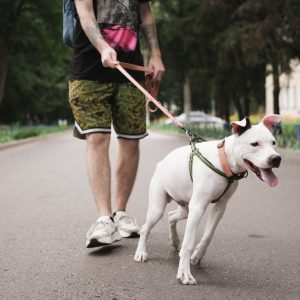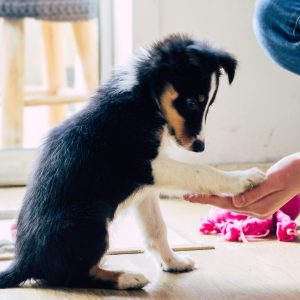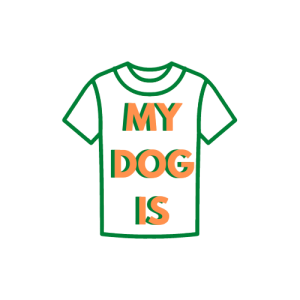Your existing dog may act as if they really dislike your puppy but that may not actually be what is happening. Instead, the older dog may simply be impatient with a youngster that doesn’t yet understand dog behaviour and etiquette, and may not be enthralled by the prospect of having to take a young dog under its wing. An older dog might also feel threatened by the introduction of another dog into their home or even into the family group that they know and understand. This can be a bigger problem if the puppy has been separated from its litter mates early and may have missed out on some of the maternal training that quietly goes on while the puppies are still with their mother.
What if my older dog doesn’t welcome the puppy into our home?
Some of your older dog’s reaction may be a product of age as, in their natural habitat, the seniors within the group play little part in training young dogs, leaving that to the middle generation to deal with. Additionally, older dogs have usually adapted to their environment and are largely happy with how things are. It’s easy to understand how they may not entirely welcome a space-invader with boundless energy and very few manners.
What should I expect?
Much will depend on your older dog’s natural personality. If the dog is usually playful and exuberant, he or she might welcome the puppy with playful abandon while a quiet, more introspective dog may simply ignore the puppy as much as possible. Behaviour that is at odds with what you might normally see when your dog meets another one should be a sign that things need watching closely. If there is one golden rule, it would be that you should never leave the dog and the puppy alone, even for a few minutes, in these early stages.

What can I do to help the situation?
If possible, bring a piece of blanket that smells of the puppy home with you before the puppy comes home so that your older dog is familiar with the smell. Then, if possible, introduce the two of them on neutral ground but bear in mind that your puppy is not yet protected by vaccination against disease, so make sure this meeting takes place somewhere safe where other dogs have not been.
Keep the introduction short and calm, avoiding any boisterous play or overt favouritism towards the puppy that might cause concern about displacement in your older dog. The puppy is likely to be submissive and if the older dog continues to show signs of aggression, it’s clear that you will need to manage this process gradually and carefully. You can minimise any possible friction by positive reinforcement to help your older dog associate the puppy with things that he or she loves such as reward in various kinds – praise, cuddles, treats are all positive reinforcements.
At all times, stay calm and in control of the situation. Use a calm, quiet voice and keep your approach friendly so that you set the tone for your existing dog to pick up. Dogs read our demeanour and behaviour all the time and this is the single biggest contribution you can make as the owner of the older dog.
Treats are a useful way of starting off this introduction and use as many as necessary to keep things calm between the two dogs.
Have the lead ready so that you can gently remove your older dog from close proximity, if necessary. Do not scold the older dog as this establishes a negative connection.
If your older dog has a favourite toy or ball, remove this beforehand so that there is no need for them to ‘guard’ precious resources.
Will things change?
Older dogs usually employ a strategy of diminishing tolerance with puppies – when the puppy is very young, they will tolerate most things, once they’ve laid down some ground rules. Early on, they may even let the puppy climb into their bed or play with their favourite toy but, each month or so, that tolerance is withdrawn a little bit as progressively, they work on instilling good manners into the puppy. This process may last several months but is usually complete by the time the puppy is around nine months old by which time the older dog sees the youngster as an equal and has the expectation that good manners will prevail.
Throughout this process, the older dog needs to let the young one know when they have stepped over the line. This is usually done by a growl or sometimes with some gentle, physical restraint and the puppy usually understands and responds appropriately. This behaviour is not just normal, it is desirable as no-one wants a puppy that is out of control.
If these interventions by the older dog are frankly aggressive, you will need to take charge of the situation. NEVER try to intervene by getting between the dogs but, instead, quietly remove the older dog from the situation and return the puppy to its safe zone.
- In cases where the aggression is serious and the puppy could be at risk, you should immediately seek the advice of your veterinary surgeon who may refer you to a qualified animal behaviourist.
Do these same measures apply with older dogs that are not my own?
The short answer is yes, although it is vital that you don’t seek to socialise your puppy with other dogs until that puppy has been fully protected from disease by vaccination.
The responsibility to open the dialogue lies equally with both humans if the puppy meets another less welcoming dog. The secret is to keep the peace and try again later so, if the older dog is not your own, remove the puppy from the situation and don’t hesitate to say that you understand that puppies can be very annoying. If your dog is bothered by someone else’s puppy, make sure you calmly make it clear that your dog doesn’t like puppies and, wherever possible, move out of their way.
In most urban situations, the dogs that you meet today may well be the dogs you will meet every day for years to come. Any tensions minimised now will help you and your dog co-exist happily with a wide range of dogs and their owners in the future.
For more information about introducing a puppy into its new home or for introducing a puppy to children, visit our article section.









